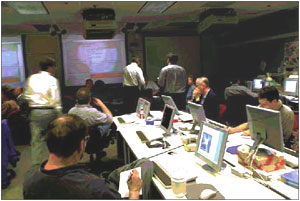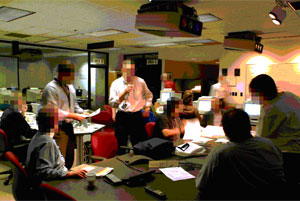UCI's Gloria Mark Studies How Technology Impacts Behavior
|
September 1, 2004 -- Gloria Mark's area of expertise is computer-supported cooperative work, that is, the design, use, and support of collaborative technologies. "My research lies at the intersection of human behavior and technology use -- how technology impacts behavior," she says.
Mark's work falls into two camps: laboratory experimentation and field work. The former is used to test new prototypes. She recently did a study to understand how collocated and distributed work affects the use of collaborative visualization technologies.
"What we found is that collocated groups of people catch more mistakes than a distributed set of individuals," says Mark. "But such groups are not necessarily more efficient in the sense that there's not a clear cost/benefit to grouping people together in front of the same display."
Mark and colleagues developed a model to describe the stages for making decisions using visualization technologies, and these results were presented in papers at "Info Vis" 2002 and 2003. A paper will also appear in MIT's Presence journal. The model can be used by usability engineers and designers to understand where usage problems lie in a collaborative visualization system. The model can also be used to compare systems and aid developers to ensure that each stage of the visualization process is supported adequately.
Mark describes field work as "more representative" of the real use of technology. "It's sort of like studying the use of IT in the wild," she says.
She works with various companies and research labs. A project funded by the Jet Propulsion Lab, for example, over the last three years studied large-scale distributed team collaboration in space mission design. "We were looking at sources of risk due to the nature of the organization and human factors. And, in fact, NASA is now using our results." They have developed a prototype voice system to enable peer-to-peer communication during the team design process. Early observations suggest that some sites are more willing to adopt this technology than others.
|
Since 1998, Mark has worked with Boeing, a large, distributed, international company. "There we're looking at issues related to the adoption of collaborative technology across distance and conducting empirical studies of distributed requirements for groups such as Boeing's vendors, engineers, and software developers," she says.
According to Mark, there is a lack of empirical studies of how people actually formulate and assess requirements in real projects. "We have had papers on this topic in the IEEE Requirements Engineering conferences the last three years in which we provide evidence that contradicts formal requirements models," she says with obvious excitement.
And her work apparently is having a serious impact. "We've published papers for the last three years - as 'outsiders' really, because our topics seemed outside of mainstream interests. But this year's call for papers expressly requested empirical studies of requirements analysis!"
Intel, another company Marks works with, calls itself a "virtual organization" as exemplified by their policy to hire the best person for the job irrespective of where the person is located geographically. "Intel's goal is to make this distributed environment work in a practical way," she says.
For Intel, Mark did a large-scale study, based on surveys and observations, of 70 distributed teams. "One of the things we focused on," she says, "was team size."
With a smaller team, the members were likely to be more active; committed; aware of team goals; aware of other team members' work roles, communication styles, and personalities; and had higher levels of rapport.
Larger teams, however, focused more on coordination; for example, they paid more attention to preparing meeting agendas in advance. They adopted technology to support coordination of asynchronous work, while the smaller teams adopted collaborative technology to support synchronous communications. "The survey results have been published, and we have a large dataset we are still mining," says Mark.
In another study with local Irvine software companies, Mark and her graduate student Victor Gonzalez are analyzing how people manage their time and their many projects over the course of the day. So far she has studied 24 people and analyzed data from 14 in depth. An observer typically sits behind the subject, say a financial analyst, manager, or developer, with a timer. Every time the person changes activities, for example, from a phone call to doing e-mail, opening an MS Word document, or experiencing a personal interruption, the observer notes that down.
|
According to Mark's results, the average duration of an activity is three minutes. People spend even less time working on any particular device, such as a phone or software application: The average in that case is a mere two minutes.
"We also are looking at 'working spheres,' as we call them," says Mark. A working sphere can be thought of like a project, where a specific set of people work on the same goal, have a timeline, share resources, etc.
Mark has worked with a women's mentoring program to attract women to computer science and, through this program, has taken on a student to develop a linear, time-based map format that visualizes these changes in a person's activity over the course of a day.
According to Mark's results, people change their working spheres, on average, every 11-1/2 minutes. This leads quickly to the conclusion that the modern-day working environment is very "fragmented."
Mark emphasizes that there's no software that maintains continuity to support human activity. That burden falls on individuals to maintain it, typically through low-tech methods: post-it notes, face-to-face reminders to each other to do things, etc. These results have been reported on in an article on multitasking in the Wall Street Journal (November 10, 2003). The study has also been published in the ACM CHI conference.
Mark is a member of the Interactive Collaborative Technologies research group, which grew out of an older group called CORPS, which focused on computing, organizations, policy, and social issues. The group includes Bonnie Nardi, an anthropologist focusing on human behavior and cultural issues; she has studied the role of instant messaging and is now studying blogging (an acronym for Web logging). It also includes Paul Dourish, who studies systems from a developer point of view (and is the newly appointed associate director for research of the UCI division of Calit²), and Alfred Kobsa who studies human-computer interfaces, privacy issues, and information visualization.
How do researchers respond when asked to be study subjects? Some see the benefit in participating if it means the results of the study might be fed into development of better collaborative technology. For others, it is a chance for them to be reflective of their work. "But, yes, this is an issue," says Mark matter of factly. " The hardest thing for us is to get buy in from the research subjects."
This point needs to be emphasized, says Mark, because she depends on technical people and their expertise to conduct her research. And she says she's always looking for new "field sites," which could include companies interested in improving their distributed collaboration and large, interdisciplinary, distributed academic research collaborations. Particularly on her radar screen in this regard are a few key Calit² projects, such as OptIPuter, BIRN, and RESCUE.



